
Johan Christian Fabricius was a Danish zoologist, specialising in "Insecta", which at that time included all arthropods: insects, arachnids, crustaceans and others. He was a student of Carl Linnaeus, and is considered one of the most important entomologists of the 18th century, having named nearly 10,000 species of animals, and established the basis for the modern insect classification.

Sphaerites is a genus of beetles, the only genus in the family Sphaeritidae, sometimes called the false clown beetles. It is closely related to the clown beetles but with distinct characteristics. There are five known species, widespread in temperate area but not commonly seen.

With over 500 species, Xyleborus is by far the largest ambrosia beetle genus in the tribe Xyleborini.
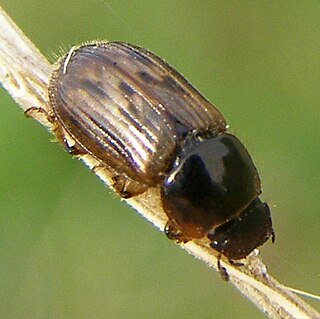
Aphodius is a genus of beetles in the family Scarabaeidae. In most species both the adults and larvae are coprophagous although some species have herbivorous or saprophagous larvae. Aphodius species typically dominate dung beetle communities in north temperate ecosystems. Most species are functionally classified as endocoprids, also known as dwellers, because the larvae live and feed within the dung pat itself.
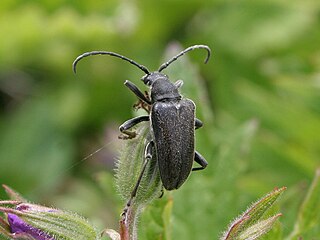
Acmaeops septentrionis is a species of the Lepturinae subfamily in the long-horned beetle family. This beetle is distributed in Austria, Belarus, Bulgaria, Czech Republic, Estonia, Finland, France, Germany, China, Italy, Japan, Latvia, Lithuania, Mongolia, North Korea, Norway, Poland, South Korea, Romania, Russia, Slovakia, Slovenia, Sweden, Switzerland, and Ukraine. Adult beetle feeds on Norway spruce.

Acmaeops marginata is a species of the Lepturinae subfamily in the longhorn beetle family. It was described by Johan Christian Fabricius in 1781 and is known from Austria, Belarus, Belgium, Baltic states, Bosnia and Herzegovina, Croatia, Czech Republic, Finland, France, Germany, Greece, Italy, Norway, Poland, Russia, Serbia, Slovakia, Spain, Sweden, Switzerland, Ukraine, China, Mongolia, and Montenegro. Adult beetle feeds on Scots pine, and Norway spruce.

Acmaeops proteus is a species of the Lepturinae subfamily in the long-horned beetle family. This beetle is distributed in Canada, Mexico, and the United States.

Acmaeops pratensis is a species of the Lepturinae subfamily in the long-horned beetle family. This beetle is distributed in Austria, Belarus, Bosnia and Herzegovina, Bulgaria, Canada, Croatia, Czech Republic, Estonia, Finland, France, Germany, Hungary, China, Italy, Kazakhstan, Latvia, Lithuania, Moldova, Mongolia, Montenegro, North Macedonia, Norway, Poland, Romania, Russia, Serbia, Slovakia, Slovenia, Spain, Sweden, Switzerland, Ukraine, and the United States. The adult beetle feeds on Norway spruce.

Dinoptera collaris is the species of the Lepturinae subfamily in long-horned beetle family.
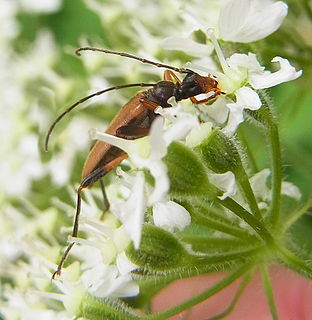
Pidonia lurida is a species of the Lepturinae subfamily in the long-horned beetle family. This beetle is distributed in Central and Southeast Europe, Russia, north of Italy and France. Larvae develop in deciduous and coniferous trees.

Macroplea mutica is a species of leaf beetles of the subfamily Donaciinae. It considered to be a Palearctic species, but can be found in Central Europe and Turkey.

Agapanthia is a genus of flat-faced longhorn beetle belonging to the family Cerambycidae, subfamily Lamiinae.

Acmaeops is a genus of beetles in the family Cerambycidae, containing the following species:
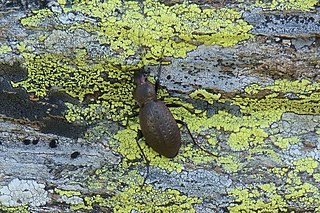
Carabus concolor is a species of beetle from ground beetle family that can be found in Italy, Liechtenstein, and Switzerland. The species are brown coloured.
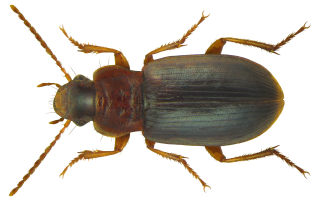
Ophonus rufibarbis is a species of ground beetle that can be found everywhere in Europe and the Near East.
Acmaeops discoideus is a long-horned beetle in the flower longhorn subfamily, Lepturinae. It is found in the United States and Canada, and feeds on Virginia pine.

Ceratina smaragdula, also known as Ceratina (Pithitis) smaragdula, is a species of green metallic bees belonging to the family Apidae, subfamily Xylocopinae.
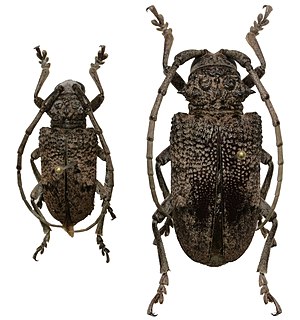
The Fig-tree Borer Longhorn Beetle, or Fig Tree Borer, is a species of beetle in the family Cerambycidae. It was described by Johan Christian Fabricius in 1792, originally under the genus Lamia. It has a wide distribution throughout Africa. It feeds on Pyrus communis, Ficus carica, Salix babylonica, Cupressus sempervirens, and Vitis vinifera.

Mycetophagus is a genus of hairy fungus beetles in the family Mycetophagidae. There are at least 20 described species in Mycetophagus.
Upis is a genus of beetles, belonging to the family Tenebrionidae.


















